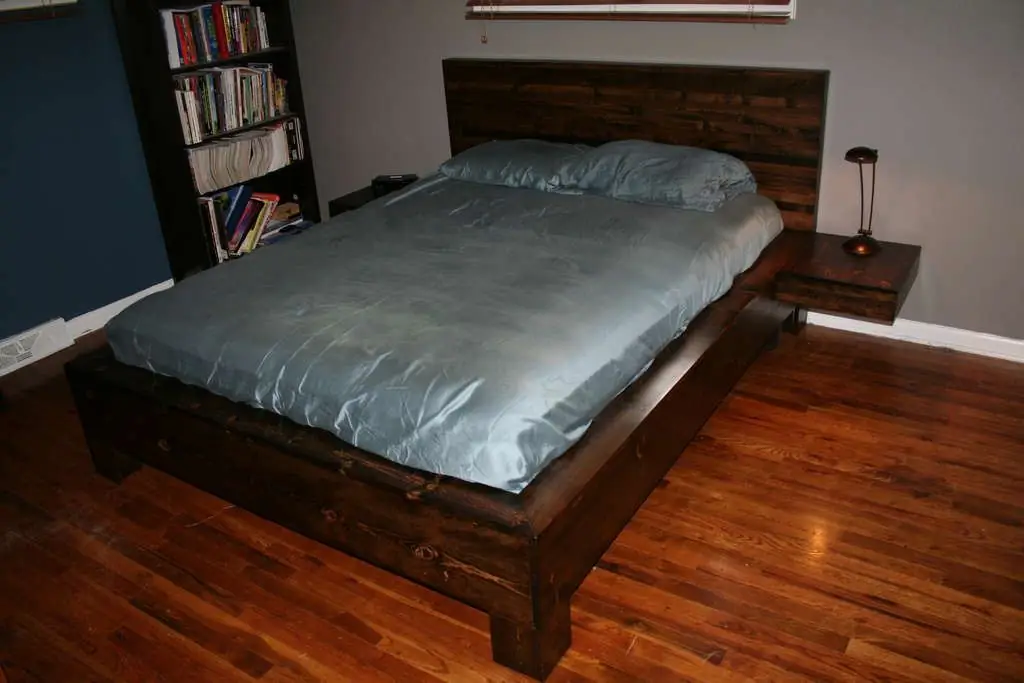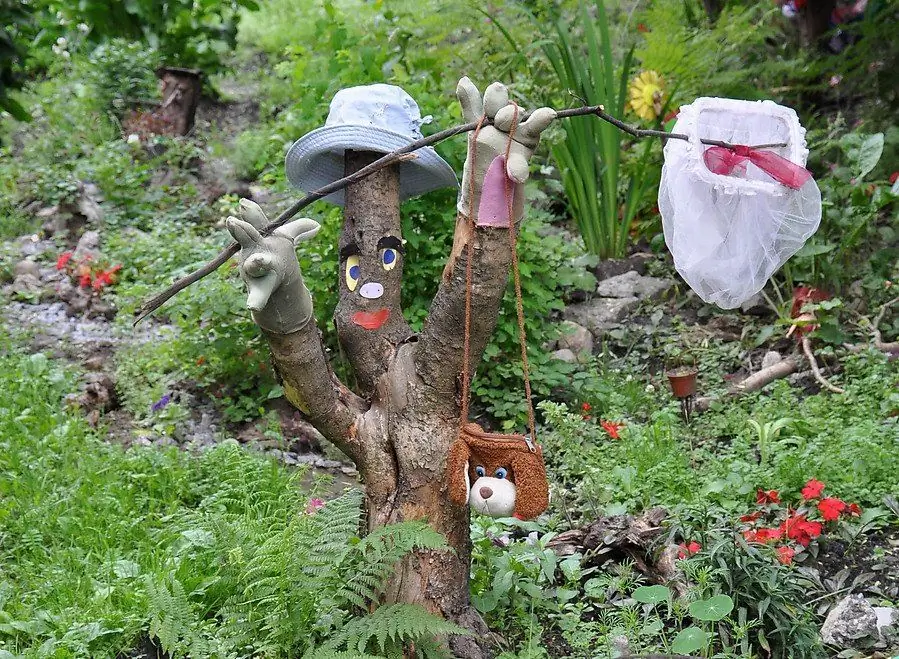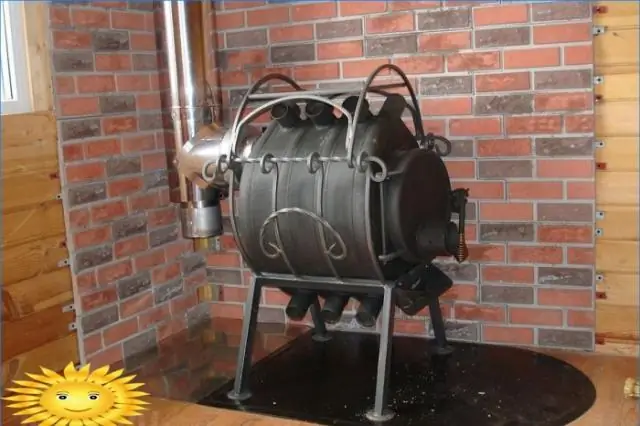
Table of contents:
- Author Bailey Albertson [email protected].
- Public 2023-12-17 12:53.
- Last modified 2025-01-23 12:41.
DIY wooden bed

As you know, finished furniture, including a bed, is quite expensive, and exclusivity and certain differences from standards increase the price several times. But everyone wants to have special furniture in their home. What to do in this case? The answer is simple - you can make the bed yourself. And you don't have to be a professional carpenter for this. You just need to be patient, concentrate and follow the recommendations outlined in this article.
Consider a method of making a bed with recently fashionable floating bedside tables. This model is very simple, but at the same time it looks original and modern. This bed will not only serve as an exclusive element of the interior, but will also help save finances.
Content
- 1 Tools and Materials You Will Need
- 2 Manufacturing the bed frame
- 3 Exterior decoration
- 4 Headboard and floating bedside tables
- 5 Finishing the product
- 6 Related Videos
Tools and Materials You Will Need
Before starting work on making the bed, stock up on everything you need so that in the process you do not have to waste time looking for the right little thing. You will need:
- miter saw;
- circular table saw;
- hammer and nails (modern compressor and nailer can be used);
- an assortment of sandpaper with a grain size of 80-150 or 180-220 (an orbital sander will greatly facilitate the work);
- drill screwdriver;
- rubber mallet;
- roulette;
- pencil;
- square;
- clamps;
- socket wrench and replaceable heads for it;
- sawhorses;
- putty knife;
- screws 40 and 60 mm;
- stain and matte or glossy varnish - per liter;
- joiner's glue;
- wood putty;
- White Spirit;
- sponges and rags.

Now let's move on to lumber. Their number and size directly depend on how large the bed will be. In determining them, you will be helped by the sizes of mattresses accepted by the standards. For a large double bed frame you will need:
- Beam 2.6 meters long, with a section of 100 x 100 mm
- Beam 2.6 meters long, with a section of 50 x 50 mm
- Boards 2 meters long, with a section of 25 x 75 mm - about 20 pcs.
- Boards 2.6 meters long, with a section of 50 x 100 mm - 6 pcs.
For finishing you will need the following materials:
- Boards 2.6 meters long, with a section of 25 x 250 mm - 2 pcs.
- Boards 2 meters long, with a section of 25 x 250 mm - 1 pc.
- Boards 2.6 meters long, with a section of 25 x 150 mm - 4 pcs.
- Boards 2.6 meters long, with a section of 25 x 100 mm - 1 pc.
The owner makes the choice of wood species for finishing materials himself, based on his preferences and capabilities. Oak, mahogany and walnut are quite expensive, with pine being the most suitable of the more budget options.
Bed frame manufacturing
So, let's start making the bed. Start with a wireframe. This work is the simplest in the whole project, any mistakes can be easily revised and corrected. In addition, the appearance of the frame is not particularly important, it will be hidden under the finish. The most important thing is structural reliability.

First, decide what height of the legs you need. The height of the side panels is added to this. Cut four equal pieces of the required length from a bar with a section of 100 x 100 mm. Attach fasteners to them at the same height, one for each segment. Fasteners are fixed with nails or screws.
Now get to work on the width of the bed. You should measure the width of the mattress, and adding a few centimeters of stock on each side, cut off two pieces of this length from the board 50 x 100 mm. These boards are fixed in metal brackets that were previously installed on legs.
Now measure the length of the mattress. Based on the result obtained, cut off two pieces from the same 50 x 100 mm board, which will be shorter than the mattress by the size of the legs width.
In case your mattress is very wide, you will need a central support beam on the frame to help distribute the weight and avoid deflection of the structure. To do this, measure the distance between the short sides, saw off the board of the appropriate length and fix it with special metal fasteners in the center of the rectangular base of the frame.
Now place it across the base of the 25 x 75 mm board. The gap between them should be about 50 mm. These boards, in addition to placing a mattress on them, will provide additional cushioning. Their length is equal to the width of the bed, they are attached to the body with screws.
External finishing
Place the frame in an upside-down position before finishing the bed. Place a 25 x 250 mm board pre-selected for finishing along one side, and saw off the excess according to the required length. Do the same work from the opposite side. Attach the sawn boards to the sides of the frame along which the measurements were taken. The other two sides will also serve to measure the desired length of the boards. Measure and cut along the lines.
The prepared planks are attached to the frame surface with wood glue and aligned along the upper plane of the legs. Secure the planks with clamps. Now let the glue dry properly. This will take several hours.

In the meantime, you can start assembling the top edge. It will require a board, the width of which is about 11 cm. You can take a wider board from the already prepared ones, and saw off the excess from it. The length of the sawn boards should be equal to the sides of the rectangular base of the body. At the ends of each of them, a bevel of 45 degrees should be made. Install small stiffening ribs from a bar with a cross section of 50 x 50 mm on the walls and fix with nails and glue.
Now you should hide the legs of the future bed. To do this, cut out planks, the height of which should be about 1-1.5 cm less than the height of the legs. This will correctly distribute the load, directing it to the legs, and not to the planks. Fasten them with screws, nails and glue, being careful not to show the fasteners.
Headboard and floating bedside tables
To keep the headboard neat, first set its height. Based on this value, further measurements should be made for all materials used.
Planks 10 x 100 mm are attached to the legs, which will be directed to the wall, from the back surface. Their height will be greater than the height of the base, but they should not reach the top edge of the headboard surface. The boards are fixed with clamps. Next, two holes are drilled so that the board is drilled through and the leg is partially drilled. Wrench bolts are screwed into these holes, on which the washers are pre-installed. Now attach the headboard to the bed frame.
As for the material from which the headboard can be made, it is selected based on the taste preferences and capabilities of the owner. You can use the same boards as for the entire structure, connecting them together with planks from the wrong side. There is also a more economical option: a boardboard or chipboard sheet, cut in length and width according to the specified dimensions. In order to give massiveness to such a headboard, planks of suitable width can be glued to the edges of the sides and top.

Now start making and installing floating bedside tables. This element of decor and interior got its name because it does not have legs or other supports that would stand on the floor or fasten to the wall. By attaching one side to the bed frame, such a nightstand seems to float side by side.
For the manufacture of countertops for the bedside table, you can use the same boardboard as for the headboard, or type from the boards with your own hands. In this case, the wood grain should be parallel to the surface of the bed frame.
Screw the boards on which the nightstands will be attached along the sides of the bed. Moreover, the length of such boards should be less than the depth of the bedside tables. Attach the planks below the edge to a size that matches the thickness of the table top. This will ensure that the installed worktop is level with the top edge of the base. Now you need to fix the countertops and place additional boards of arbitrary size around the perimeter to give visual massiveness to your bedside tables.
Finishing the product
After the installation of the bed body is completed, you should start finishing the surfaces. Begin by sanding each piece with the coarsest grit, gradually working down to the finer grit . Surfaces should be treated so that they are completely smooth to the touch.

After that, the sanded surfaces should be thoroughly wiped with a dry cloth to completely clean them of debris and dust. Do not use a damp cloth for this: due to the effect of moisture, the smoothness of the wood will come to naught, and you will have to start sanding the surface again.
Now cover the entire body of the bed with a stain. Its color can be whatever you wish, there is a large selection of this material on the market. The saturation and depth of the final color will depend on the number of layers applied: the thicker, the darker.
After the stain is completely dry, varnish the surface.

The choice of glossy or matte varnish also depends on your own preference. At the end of work, leave the varnished bed for a day to dry.
Related Videos
Well, now your bed is completely ready. Note that it will be completely exclusive. And the fact that you made it with your own hands will give it additional charm, and you will be proud of it. On such a bed you will have the most wonderful and cozy dreams.
As you can see, even such a complex-looking structure as exclusive furniture is quite easy and simple to do on your own, without spending too much money on it.
Recommended:
Making Garden Paths With Your Own Hands - Tips + Video

Practical advice on the construction of paths in the garden. Materials used, recommendations
Making A Buleryan (breneran) Stove With Your Own Hands: Advantages And Disadvantages Of The Design, A Device With Drawings, Instructions With A Video, Etc

Design and principle of operation of the "Buleryan" furnace (breran). DIY recommendations with instructions and drawings. Maintenance and operation
How To Make A Bed For Dolls Monster High With Your Own Hands + Video

Several options for making beds for Monster High dolls. Necessary materials and tools, a step-by-step description of the process with a photo
How To Make A Bunk Bed With Your Own Hands: A Diagram, Step-by-step Instructions, Etc. + Drawings, Photos And Videos

A bunk bed is easy to make with your own hands. Homemade bunk bed options. Drawings, step-by-step instructions, helpful tips
Making A Bookcase With Your Own Hands + Video

Recommendations and step-by-step instructions for making a bookcase. Required materials and tools
